|
313-315 (10) Kirkdale
Sydenham
020 8659 0231
https://www.thegreyhoundsydenham.co.uk
https://whatpub.com/greyhound
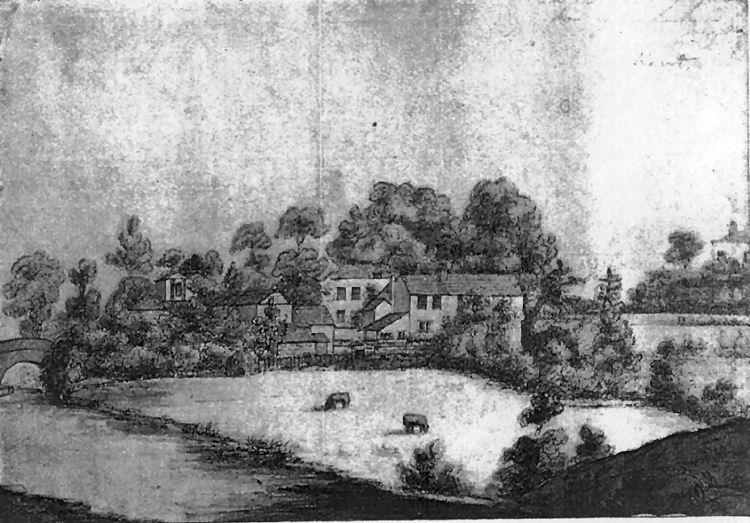
Above drawing 1818, showing the Croyden Canal bottom left. |

Above drawing 1850s, seen from the entrance to Kirkdale. The "Greyhound"
being shown in its old alignment towards Kirkdale (and formerly the
common) is on the left, the original booking hall of Sydenham station
(demolished 1979) is in the centre, and Sydenham Place on the right. |
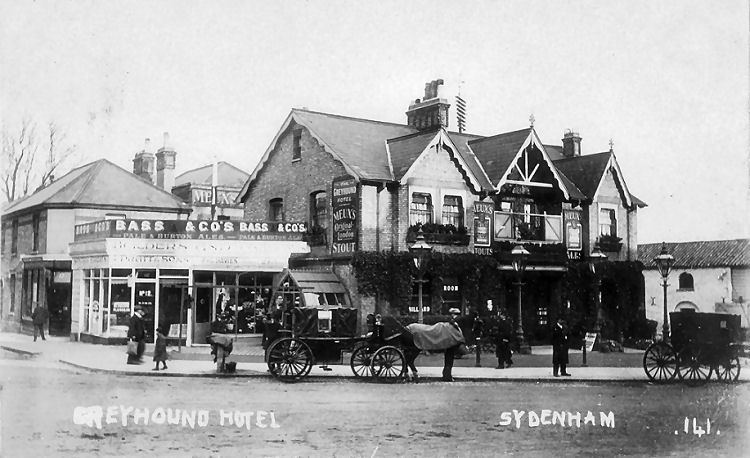
Above postcard, circa 1890, kindly sent by Rory Kehoe. |

Above photo circa 1900. |

Above photo, date unknown. |

Above postcard, 1905. |
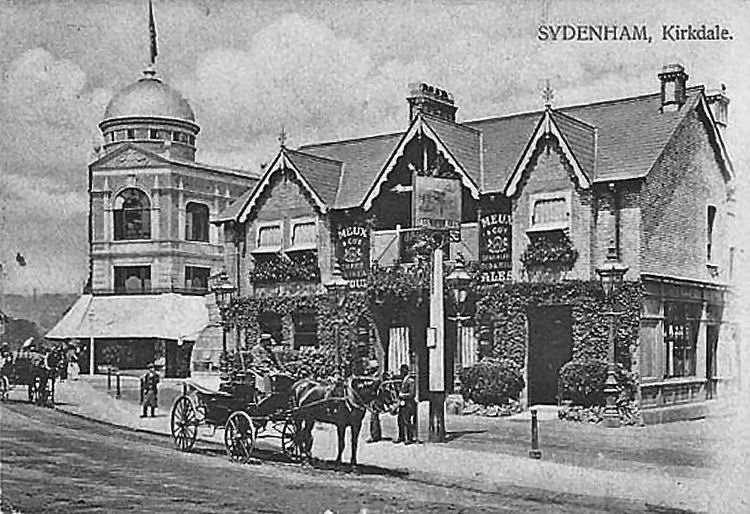
Above postcard, postmarked 1906. |

Above postcard, circa 1910. |
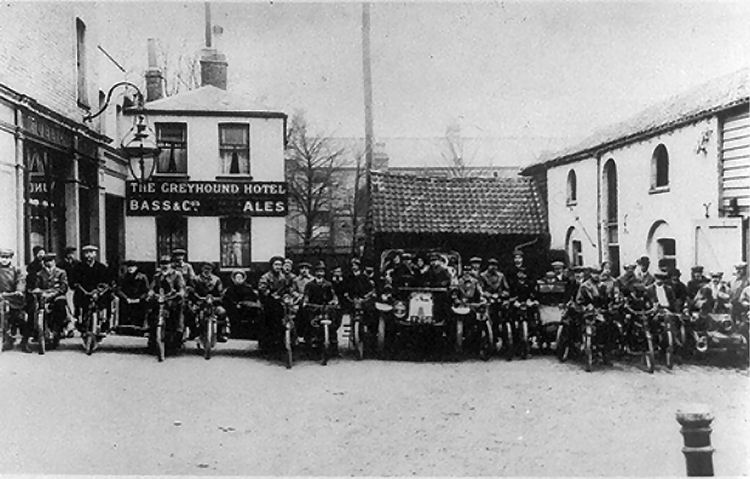
Above photo, date unknown. |

Above postcard, date unknown. |

Above photo, 1981. |
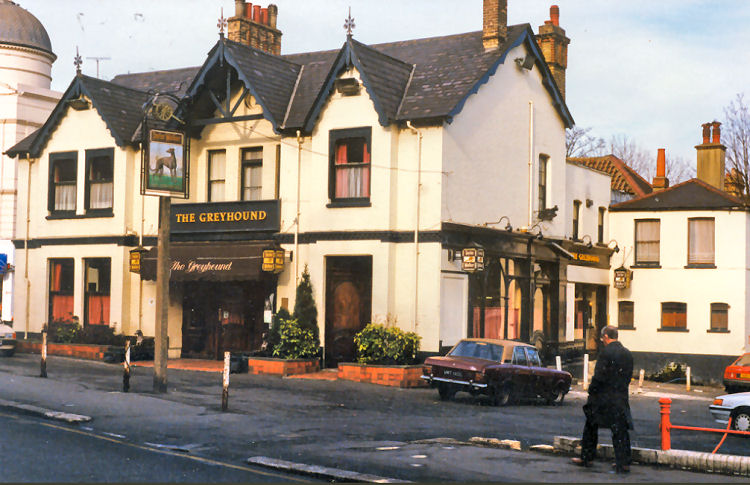
Above photo, date unknown, taken by Steve Grindlay. |

Above photo 2003. |
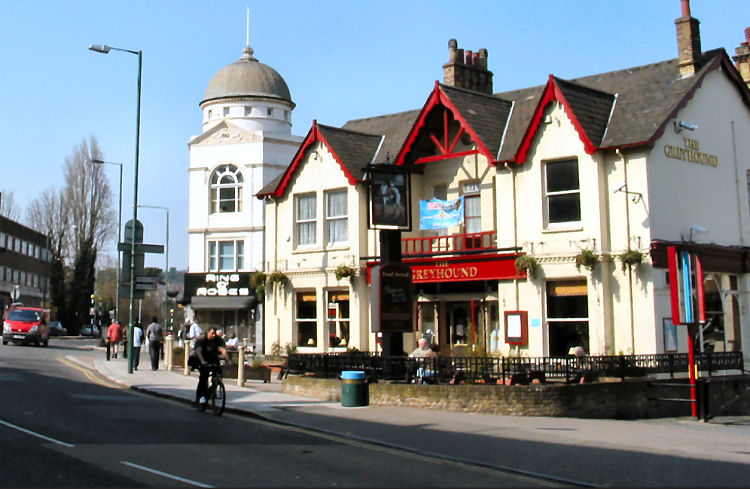
Above photo, 2007 taken by Steve Grindlay. |
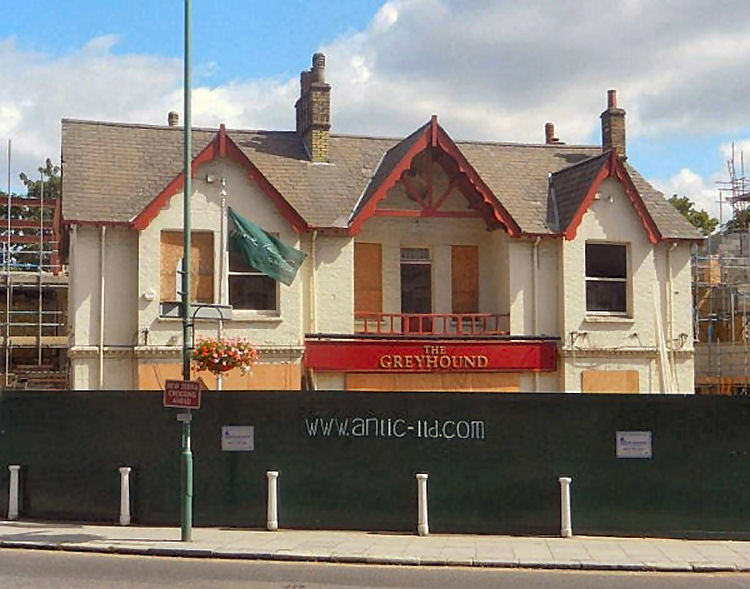
Above photo, July 2011. Taken by Stephen Harris. |
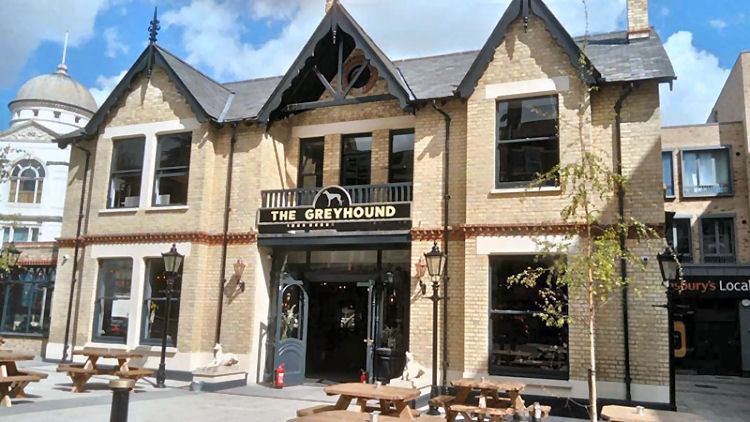
Above photo 2018. |
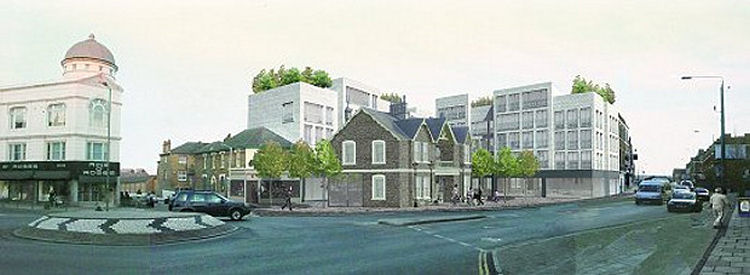
Above photo, date unknown. |
Sydenham was located in Kent until 1889 when the County of London was
formed and in 1965 it became part of the current London Borough. It is now a
suburban district of South London in the London Boroughs of Lewisham,
Bromley and Southwark.
Your help is appreciated, and every email is answered.
There has been an inn on this site since at least 1720. The oldest part
of the building at the rear was 18th century.
The Inn was used as a meeting place for local hunts. The greyhound being
bred for hunting, using speed and keenness of sight. Until at least 1812 the
Old Surrey Hounds would meet at the Inn. Trade was boosted with the building
of the Croydon Canal, which operated between 1807 and 1836. The inn was a
convenient meeting place for the directors of the company and provided
refreshment for workmen who built the canal. In 1807 the inn had a boat and
boat-house, as the landlord was accused of not allowing the boat to be used
to rescue a man who had fallen into the canal reservoir and drowned. The man
had been trying to retrieve a duck he had shot.
The poet Thomas Campbell lived locally and regularly used the Greyhound
and believed to have entertained some of his distinguished visitors (who
included Sir Walter Scott & Lord Byron) at the inn.
|
Sydenham Times, 4 November 1862.
Frightful Death.
An inquest was held at the "Greyhound Tavern," Sydenham, on Saturday
evening, by C. J. Carttar, Esq, coroner for West Kent, on the death
of Uriah Savage, who met a frightful death at the Sydenham tunnel of
the London, Chatham, and Dover Railway, on Thursday morning last.
The following gentlemen were on the jury:- Mr. Lang (foreman),
Messrs. Newnham, Stray, Rose, Cobb, Wood, Gould, Johnson, Russell,
Tucker, Berrill, Broughton, and Owen. The jury having been sworn,
proceeded to the dead house, Sydenham Church to view the body, which
was dreadfully mangled, and on their return to the inquest room the
enquiry proceeded.
William Savage said the deceased was his brother. He was 30 years
old, married, but had left no family, he was in the employ of
Messrs. Peto and Betts, as foreman of labourers.
Isaac Walters, 1, Pennington-cottages, Lower Norwood, said he was
working near the mill at ten o’clock on Thursday, and saw Savage
near there, and immediately heard a loud scream; and thinking
deceased had fallen against some part of the machinery, he ran and
stopped the engine, and on returning to the mill found the poor
fellow with his head under one of the large iron crushers. With the
assistance of other workmen he got him out and went for Mr. Stutter,
of Sydenham, who, on arriving a few minutes after, found he was
quite dead. In answer to questions from the learned coroner and
jury, the witness said deceased need not have gone on to the stage
round the mill as its working could be seen from the ground.
He (witness) had not charge of the engine, but knew how to stop it
and did so, on hearing deceased scream.
Mr. Mills, an engineer in the employ of Messrs. Feto and Betts, said
the mill was used for the purpose of grinding the waste pieces of
brick brought up from the tunnel to be again made into bricks. The
pieces were thrown from a truck into a large iron pan, about ten
feet in diameter, in which revolved two large iron wheels or
crushers, the whole being worked by a strap attached to the engine,
and placed on a stage five feet from the ground, so that no person
could by any means fall against the mill without first getting on to
the stage, and in his opinion there was no necessity for deceased to
get there.
By a juryman:- The object of the stage was to raise the mill on to a
level with the tracks containing the materials with which the mill
was supplied. He did not consider it necessary to have a railing
round the mill, as no person could fall against it without first
getting on to the platform, which was quite unnecessary. Some parts
of the mill would occasionally get clogged, and deceased had been
seen to remove the obstruction with his foot, which was highly
dangerous, and it was his opinion that he had attempted to clear the
mill by that means and that his foot was drawn into the machinery.
A juryman having suggested that a railing round the mill would give
increased security to those employed about it. Mr. Mills said that
suggestion would be attended to.
The jury, after a abort consultation returned a verdict of
"Accidental Death."
It may not be out of place to remark that the so-called dead house
in which the body was placed is quite unfit for such a purpose,
being nothing more than the furnace room for warming the church, and
reached by descending a flight of narrow steps with a second flight
on the inside, down which one of the jurymen had a heavy fall, when
proceeding to view the body, but fortunately without receiving
serious injury.
|
|
Sydenham Times, 18 November 1862.
Charge Of Embezzlement.
George Gale, a bell-hanger, residing at Upper Norwood, was
apprehended on Sunday morning 9th inst., by P.C. J. Critchell, on a
charge of defrauding Foresters Court Fancy, 1968, held at Brother
Austen's, "Greyhound Inn," Sydenham. The prisoner was taken before
J. Traill, Esq., at the Greenwich Police court on Monday, the 10th,
and by the evidence it appeared that the accused was one of the
woodwards appointed by the court for the purpose of attending the
sick and paying them their weekly sick allowance. One of the
brothers of the society, who had been ill, having recovered his
health on notice of a declaration off the club, and gave it to the
prisoner to hand over to the secretary but instead of doing so he
destroyed the notice and called upon the treasurer for the usual
weekly sum of 14s. and received that sum, and appropriating the
money to his own use. The officers of the court, in a spirit of great
kindness, having no wish to prosecute the prisoner on account of his
wife and family, offered him, as a change of escape, the opportunity
at paying the sum stolen, which amounted to £2 16s. The prisoner’s
friends came forward and paid the money, and thanked the officers of
the court for their extreme leniency. The worthy Magistrates, after
a caution, dismissed the prisoner.
|
| From
http://sydenhamforesthillhistory.blogspot.com/2008/11/greyhound-inn-sydenham.html
There has been an inn on this site since 1720, and possibly as early
as 1713. Joseph Hyde was the first recorded landlord, mentioned in
1726, and the inn is first referred to as The Greyhound in 1727, and
again in 1729 when parish registers record the burial of Joseph Hyde
in St Mary's Church, Lewisham. The oldest part of the building, made
of timber, was demolished several years ago. Its outline can still
be seen at the side of the Greyhound, from the car park.
The inn was built on the south eastern edge of Sydenham Common.
The Common, now covered by Upper Sydenham and much of Forest Hill,
was used by local people for grazing animals, gathering wood,
recreation, hunting and holding fairs. The earliest inn faced the
common (looking across Spring Hill), and had unbroken views to the
summit of Sydenham Hill. Two tracks crossed the common, one leading
to Dulwich (now Westwood Hill) and the other towards London (now
Kirkdale).
In about 1640 mineral springs, with alleged healing properties,
were discovered on Sydenham Common, in the present Wells Park Road
and Taylor's Lane area. Demand for the water increased and several
wells were sunk to ensure adequate supplies. Their popularity
increased and one visitor complained about the "rabble of Londoners"
who came to visit the wells. Visitors were accused of mixing the
water with "brandy or other strong liquors" (supplied by local
inns), and then blaming their hangovers on the water! Wealthier
visitors to the Sydenham Wells would have required lodgings and this
could have been one reason for building the inn. The popularity of
the Wells peaked with a visit from George III (in about 1760) but
then declined. The wells were filled in. During the late 19C the
last remaining well was described as "a dirty pool and the water
very nasty".
The Greyhound Inn, like inns at Dulwich, Streatham and Croydon
with the same name, was used as a meeting place for local hunts.
Greyhounds were bred for hunting, using speed and keenness of sight.
During the 18C and until 1812 or later, the Old Surrey Hounds (the
fictional Jorrock's pack) would meet at the Greyhound. The Old
Surrey hunted an area that covered Brockley, Sydenham, Dulwich,
Peckham and Croydon. Sydenham and Forest Hill were particularly
noted during the 18C for having a large fox population.
Trade at the Greyhound Inn was boosted with the building of the
Croydon Canal, which operated between 1807 and 1836. The canal
connected Croydon with the Thames and followed roughly the line of
the present railway track from New Cross Gate to Sydenham and
beyond. The inn provided refreshment for the 'navvies' who built the
canal and was also a resting place for those who used the canal for
work or recreation.
The poet Thomas Campbell lived on Peak Hill between 1804 and
1820. He regularly used the Greyhound and apparently entertained
some of his distinguished visitors (who included Sir Walter Scott,
Lord Byron, George Crabbe and Sarah Siddons) at the inn. Sir Charles
Bell (a Scottish surgeon) writes of an evening spent with Campbell
at the Greyhound when the poet returned home "not drunk, but in
excellent spirits". Other accounts suggest that there were occasions
when he had to be helped home to bed.
An early painting shows pleasure boats moored against a landing
stage near the inn, known as Doo's Wharf. Certainly in 1807 the inn
had a boat and boat-house, as the landlord was accused of not
allowing his boat to be used to rescue a man who had fallen into the
canal reservoir and drowned. The man had been trying to retrieve a
duck he had shot.
A major change to the character of the area resulted from the
passing of the Enclosure Act of 1810. This proposed the enclosure of
all common land in Lewisham, except for Blackheath. From about 1820
what had been open common, from the Greyhound to the top of Sydenham
Hill and from Westwood Hill to Honor Oak Road, was fenced in and
gradually built over.
The Croydon Canal failed and in 1836 the London & Croydon Railway
Company bought its assets. They built a railway, roughly along the
line of the canal, which opened in 1839. A station, almost adjacent
to the inn, gave yet another boost to the Greyhound.
Sydenham was becoming a thriving and populous suburb and there
was obviously a need for a more modern and prestigious inn. In 1873
an application was submitted to the Board of Works by Abraham Steer,
a Norwood builder, to add an extension to the southern side of the
building, fronting on to Kirkdale. Much of the interesting detail of
the inn dates from this time.
The character of the Greyhound Inn has undergone a number of
changes over more than 270 years. It has, at different times,
provided strong refreshment for visitors to Sydenham Wells, been a
meeting place for local huntsmen, refreshed those boating on the
Croydon Canal, played host to Georgian literati and quenched the
thirst of clerks returning from their offices in the City.
|
This appears to have changed name on a couple of occasions when bought by
different breweries. Previous to 2009 it was owned by the Firkin Brewery,
who preferred to use the name Firkin in all the pubs held by them, and this
they decided to call the "Fewterer and Firkin." A Fewterer being a keeper of
dogs, so I suppose in keeping with the original name. However, the chain and
pub closed in 2007 and the name reverted back to the "Greyhound" again.
The pub closed in 2007 amidst planning proposals for 60-70 flats and then
it caught fire whilst empty later that year.
After closing the pub was unlawfully demolished and then left partially
rebuilt.
|
From the
http://www.newsshopper.co.uk 2nd October 2014. By Carly Read.
Developer may face more legal action after Sydenham pub demolition.
Further legal action may be taken against the Bromley developer
which illegally demolished an 18th-century Sydenham pub, the Mayor
of Lewisham has warned.
The Greyhound in Kirkdale closed in 2007 and was knocked down in
2012, leaving just the front wall intact, despite it being in a
conservation area banning demolition without council consent.
Last year Lewisham Council prosecuted developer Pure Lake for the
unauthorised demolition.
The company was fined £5,000 and ordered to pay £13,000 costs by
Bromley magistrates.
Civic group The Sydenham Society is continuing to push for the pub
to be rebuilt, and last night confronted Mayor Steve Bullock and
members of the cabinet about the “eyesore” left behind by Pure Lake.
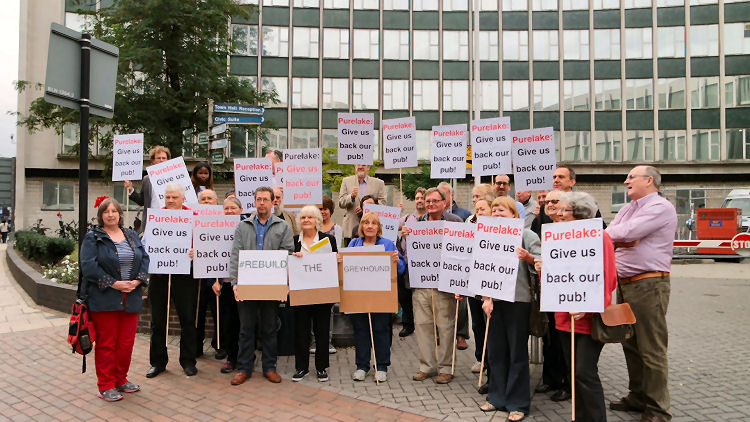
Armed with placards outside Lewisham’s civic offices, the 30-strong
group demanded: “Enough is enough, we want our pub back.”
Barry Milton, a member of the society, told the Mayor: “We have been
patient for seven years and enough is enough, we now want this issue
to be resolved in the next few months.
“We would very much like to meet with the (council) chief executive
and the Mayor as we have some ideas to put forward to do something
about this planning quagmire.”
The Mayor invited the group to attend a follow-up meeting on October
22 to consider what action should be taken.
Mr Bullock said: “This organisation (Pure Lake) has been found
guilty of a criminal act. If that implies that the council should
take legal action then that is what we want to do.”
Sydenham Society chairwoman Annabel McLaren said having her defiant
group attend the meeting was a reminder to Lewisham Council that the
half-demolished building is “ruining our community.”
She added: “I think if they are serious about taking legal action
then this is a great step in getting it resolved and the fact that
the Mayor said that Pure Lake committed a criminal offence means the
problem is finally being acknowledged.”
Pure Lake director Gerry Dowd had claimed at the time of the
demolition it had been necessary because of "structural problems" at
the building, partly caused by a fire.
|
|
In November 2014 rebuilding started, following an ultimatum
given to the developer responsible by Lewisham Council.
|
|
From the
http://www.newsshopper.co.uk 19 February 2018.
New Greyhound Pub in Sydenham opens 10 years on.
A pub in Sydenham is being brought back to life after being "totally
transformed" during a six-month refurbishment.
The Greyhound Pub will host its grand opening on Friday (February
23) after being closed for 10 years after being illegally knocked
down.
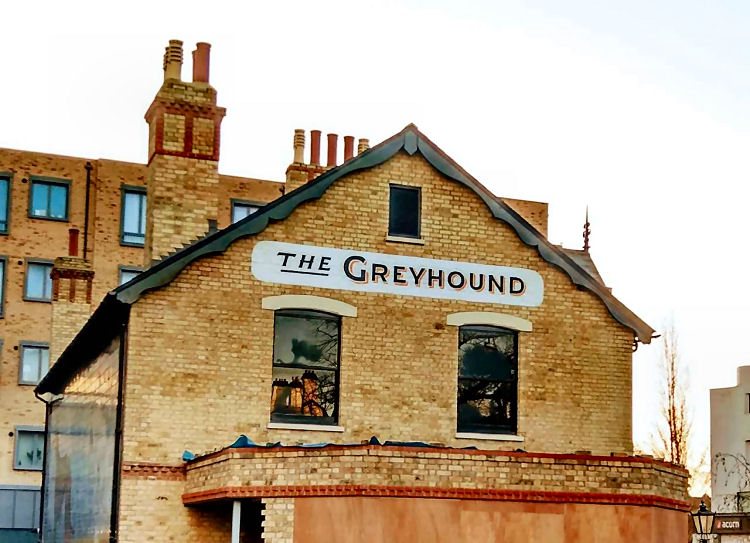
The Kirkdale pub was bulldozed by developer Purelake without
permission, causing Lewisham Council to bring them to court.
It was demolished in 2012.
In 2014 there was renewed calls for the pub to return.
New general manager, David Montgomery, said: "We have been working
on this project for many months now and are delighted to open a
civilised place to enjoy, drink and dine for Sydenham.
"In an era where an increasing number of well-loved local pubs are
transformed into alternative uses, it is wonderful that we can, at
The Greyhound, create a new heart of the community for people to
spend time in.
"Although structural issues have made the project challenging, the
result has all been worth it. I’m local myself and, as a team, we’re
excited to welcome everyone.
"The Greyhound stands for good food, good drink, good times. We
cannot wait to open."
The pub is also re-launching private dining rooms and a patio
garden, both opening in Spring.
They also confirmed that both vegetarian and vegan options will be
offered on their new menu.
The pub is located at 313-315 in Kirkdale and dogs and children are
welcome.
It will open Monday to Saturday from 11am until 11pm and on Sundays
from 12pm until 11pm. |
After a refurbishment the pub reopened in February 2018.
LICENSEE LIST
CARTER Longstaff 1815-27 (dec'd age 56)
CARTER Susannah 1832+

AUSTEN John & Edward 1862+ (also Fly Proprietors)
AUSTIN Frederick 1866+
LAVELL James Daniel Francis 1874-76+
SMITH Friend 1882-96+
DOWLING William Alfred 1901-05+

DENBURY Laura Miss 1906+
MORTLOCK Laura 1919-44+
ALISON Cynthia Sept/2017+
https://pubwiki.co.uk/GreyhoundHotel.shtml
 From the Pigot's Directory 1832-33-34 From the Pigot's Directory 1832-33-34
 From the Kelly's Directory 1903 From the Kelly's Directory 1903
|


















